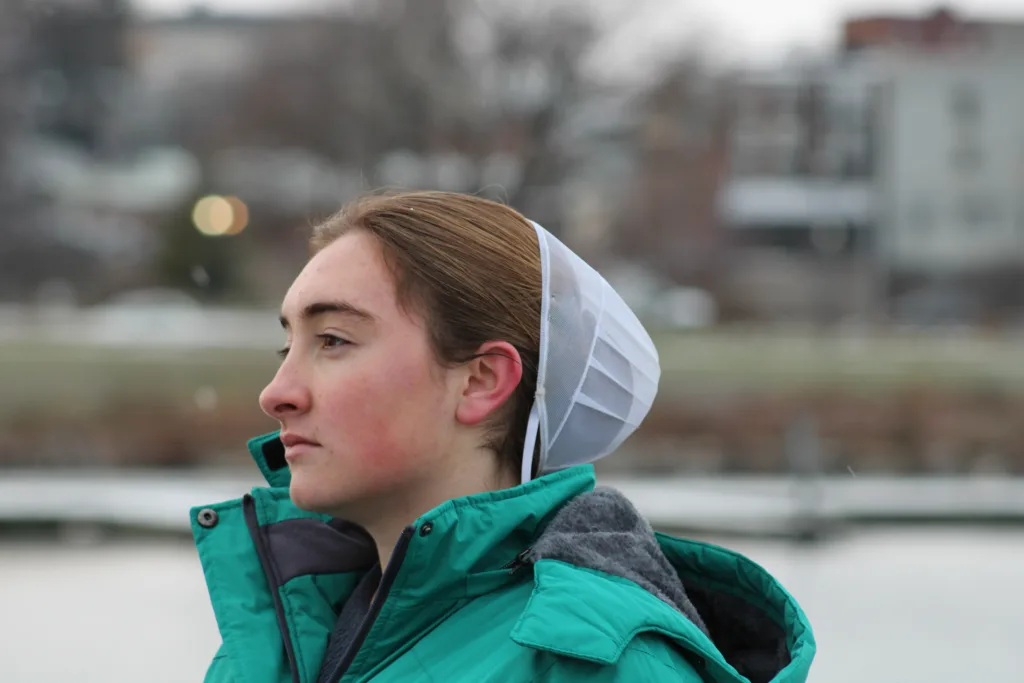The Mennonite community has a long-standing tradition of wearing head coverings, which signify a woman’s submission and humility before God. The practice of wearing a head covering has evolved over time, with varying styles, sizes, and levels of plainness being observed by different denominations and local congregations.
While the practice of wearing a head covering has largely faded away in many Christian communities, it remains a central part of the Mennonite faith. Women wear a haube, a traditional Mennonite head covering, while men may wear black hats on Sundays as a sign of their commitment to living a holy life.
The belief that women should cover their heads while praying is rooted in the Bible, with several passages referencing the practice. The Amish and Mennonites interpret these passages as a commandment from God, and thus wearing a head covering is seen as an act of obedience and reverence.
The haube itself varies in style and design, with some featuring lace veils or ornate embellishments while others are more plain and simple. The wearing of the haube is not limited to just attending church, as many Mennonite women wear it at all times as a sign of their devotion to God.
While the practice of wearing a head covering is primarily assciated with women, some conservative Mennonite men also wear black hats on Sundays as a symbol of their humility before God. This practice is not seen as a commandment from God but rather as a way for men to demonstrate their commitment to living a holy life.
The practice of wearing a head covering is deeply ingrained in the Mennonite faith and is seen as a symbol of submission and humility before God. While the style and design of the haube may vary, the underlying belief remains the same – that by covering their heads, women demonstrate their obedience to God and their commitment to living a holy life.
What Do Mennonites Wear On Their Head?
Mennonite women wear a head covering called a haube. This traditional head covering is worn by married women and varies in style, size, and plainness depending on the denomination and local congregation. Some hauben tie under the chin, while others have lace veils or are very ornate. The haube is an important symbol of modesty and humility for Mennonite women and is worn as an expression of their faith and commitment to their community.

Why Do Mennonite Girls Wear Head Coverings?
Mennonite girls wear head coverings as a symbol of their religious beliefs and to show their submission to God. This practice is based on biblical teachings that state that a woman’s head should be covered while praying or prophesying. The head covering is seen as a sign of respect for God and a reminder of the teachings of Jesus Christ. It is also believed that wearing a head covering helps to maintain modesty and purity. The practice is not limited to Mennonite girls but is also followed by many other Christian denominations such as the Amish and Brethren. The head covering can take the form of a prayer veil, a bonnet, or a scarf and is typically worn at all times, not just durng church services.
Why Do Mennonite Men Wear Hats?
Mennonite men wear hats for several reasons. Firstly, it is a symbol of their humility befoe God. Wearing a hat is seen as a way of covering their head and showing reverence to God. This practice is derived from the Bible, where Paul instructs men to uncover their heads when praying or prophesying. Secondly, Mennonite men wear black hats on Sundays as a sign of respect and reverence for the Sabbath day. This is a way of honoring God and demonstrating their commitment to living a holy life. Additionally, Mennonite men may wear hats on other days to protect their heads from the sun or cold weather. Mennonite men wear hats as a religious symbol and as a practical item of clothing.
Why Do Mennonites Wear Coverings?
Mennonites wear coverings as a sign of their belief in the Biblical command for women to cover their heads while praying. They see it as a symbol of submission to their husbands and a way to show reverence to God. This practice is not limited to prayer times but is worn all the time. It is a tradition that has been passed down from generation to generation and is an important part of their culture and faith. The covering can be a variety of styles, including a headscarf, bonnet, or hat, and is ofen made from plain or muted fabrics. Mennonites view the wearing of coverings as a way to honor their beliefs and show their commitment to their faith.

Conclusion
The Mennonite head covering, also known as the haube, is a traditional head covering worn by married women in many denominational groups. While the style, size, and plainness vary from one group to another, the practice is still observed by the Amish, Mennonites, and Brethren. The wearing of a head covering symbolizes a woman’s submission and humility before God, and is believed to be a Biblical command for women to cover their heads while praying. While the practice has been lost by many churches, it remains an important aspect of traditional Mennonite and Amish culture.
